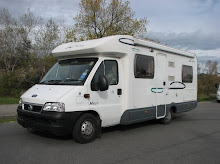







The Ebre Delta
Friday, 26th February and we leave Sitges to head south. We had tried to update the blog but the site’s wi-fi was down and the technician was expected any minute – nothing new there then!
Our aim was to stay the next two nights near the Ebre delta and explore that area of flat marsh land. The route down the coast, as expected, took us through the outskirts of some well known names of the Costa Daurada. We stopped for lunch at what we hoped would be a quiet spot and found ourselves the only people on a beach south of Salou. Pulling into our campsite for the next two nights we passed future developments for the area; roads, street lights and pavements were all installed and now waited for the erection of the apartment blocks. The site was quiet despite the close proximity of both motorway and railway and we found ourselves amongst the wintering northern Europeans from Germany and the UK. The evening was warm and we had our first bbq of the trip.
The next day, in light drizzle, we set off to explore the Delta de l’Ebre and found ourselves in flat lands which are mainly cultivated for rice. Salt is also extracted here but our objective was the bird life. Despite the weather were able to see cattle and great white egrets, flamingos and a squacco heron as well as the more familiar little egrets, marsh harriers, warblers, kingfisher and snipe. Very Sedgemoor.
On Sunday we travelled the coast road towards Valencia. The coastal strip between the sea and the mountains is jammed with villas and apartments which now form a continuous strip overrunning the individual towns and villages that once existed here. Three roads run the length of the coast to service these developments. The original N340, the motorway AP7/E15 and now, a new road is being built the A7. Along these roads, industries have sprung up to support the development; cement works, brick and tile making, plant nurseries and furniture warehouses. The hills have been scarred by quarries.
Coffee time found us in Peniscola, a fishing port with a large fortress and white-washed houses within ancient city walls. Now a popular holiday spot and obviously the place the Spanish go for Sunday lunch and the inevitable promenade.
Venturing a little away from the coast there is another world where valleys are carpeted with almond trees thick with pink blossom and orange groves as far as the eye can see. Fields are also given over to the production of vegetables – lettuces, brassicas and artichokes.
Take a route up into the mountains, as we did, towards Montanejos, west of Castellon, and you find yourself in deep valleys cut by rivers with occasional flat bottoms which support orange groves. The small villages on our route each had their own mixed market gardens and the whole area had a feeling of tranquillity.
Late in the afternoon we returned to the coastal highway and headed for Valencia before turning west towards Madrid. One of our favourite features on route were the fortresses and castles built on numerous hilltops – some now forming the “old town” and others away from any conurbation. This area was invaded many times from the sea, Greeks, Romans, Visigoths and Muslims, all came and went. On the coastal plain all was orange groves but as we climbed towards the plateau of ochre red soil these were replaced by the vine. We have now travelled through three regions of Spain, Catalonia, Valencia (all be it briefly and without stopping) and we are now in Castilla-La Mancha. How appropriate then that as we drove upwards the first thing we saw was a large wind farm. Don Quixote is alive and well.
Tonight we are camped at Villargordo del Cabriel at the southern end of the man made lake Embalse de Contreras. Just a few vans here and cooler in the hills but if the weather is good, tomorrow will be for walking.

No comments:
Post a Comment